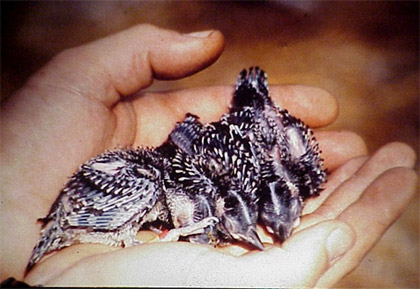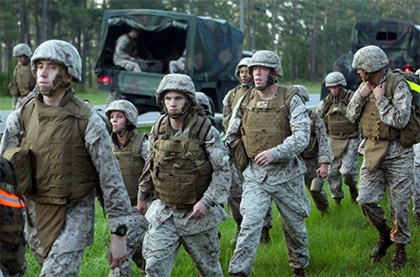The Evolution of an Environmentalist
It was the year 2000 on an early spring day at Marine Corps Base Camp Lejeune, North Carolina, the largest amphibious training base on America’s East Coast. Tramping through the swamp and Carolina pines, and trying hard to keep from walking into something they shouldn’t, was as unlikely a group of individuals as had ever been found on the Base. A dozen very senior environmentalists from The Nature Conservancy, Endangered Species Coalition, Sierra Club and several more environmental organizations were visiting to see for themselves if the Marine Corps really did have an environmental program – more importantly, an environmental ethos. I had recently been selected for Brigadier General and was nominally in charge of this group, if anyone could be said to be in charge of such a strong group of individualists.
The environmental groups and Department of Defense (DoD) had not enjoyed a warm relationship to this point. Generally, we talked past each other. Environmental groups accused the military, with some accuracy, of not doing enough to protect the land in their stewardship while the military responded that military readiness aboard installations took priority over more obtuse and defused calls to “save the planet.” However, once past the finger pointing, lawsuits, injunctions and posturing, there seemed to be a broader purpose that could be built upon. Both environmental groups and DoD had a strong love for this country and a desire to see it preserved.
With that fairly broad theme and no mandate, in my first job as a general officer and staff head of Installations for the Marine Corps, I invited our adversaries to visit a Marine Corps base. The rules were pretty simple: Go where you want; talk to who you like; look at anything you want, and draw your own conclusions.
The titular leader of the environmental groups was Brock Evans. For years Evans had been a gadfly to the Department of Defense, holding them to the standards established by law and calling them out when they failed to meet them. He had also spent several years as an enlisted Marine – a machine gunner – before going to law school and into the environmental movement. Evans was rightfully suspicious of a “dog and pony” show but willing to give the Marine Corps a chance.
As this unlikely caravan of environmentalists, military and academics moved through the swamps of Lejeune, we passed a group of Marines walking through the pines in an apparently aimless fashion. We were to learn later that it was a squad of Marines that had lost a radio in an exercise the evening before – a very bad thing for young Marines. Evans barked, “Stop the car!” Turning to me, he said, “You said we could talk to anyone. I want to talk to them.”
We approached the group of Marines who looked at us with deep suspicion. We certainly didn’t fit any profile these Marines had encountered. I introduced myself and the group, pointed to Evans and said, “This man has some questions for you.”

Photo Courtesy: U.S. Marine Corps|Red-cockaded woodpecker fledglings from Camp Lejeune, N.C.
The Marines were polite; though, I’m certain the lost radio was foremost on their minds. Evans, in his best prosecutorial manner asked, “What would happen if you disturbed the nesting site of a Red-cockaded woodpecker? And, would you even know what a nesting site looks like?”
A Marine answered, “Well sir, each pine that’s a nesting site is clearly marked and generally taped off so we know we aren’t supposed to go into them.”
Not satisfied, Evans asked, “Well, what would happen if you did disturb one of these sites?” The Marine, clearly wanting to get back to his mission, responded politely but in colorful language that if he or any other Marine disturbed the nesting site of a Red-cockaded woodpecker he would lose the most precious part of his anatomy without anesthetic. The senior Marine in the group, a corporal, salvaged the situation by clarifying that castration was really unlikely. But, it would go badly for anyone violating base environmental regulations. We let them return to looking for their lost radio. I hope they found it.
As we reentered the vehicles, Evans turned to me and said, “I’ve seen enough. If the word has trickled down to the junior Marine in the chain of command, then I believe you really are serious about the environment.”
This was the beginning of a new relationship with environmental groups. And, as the dialogue continued, I began to be asked to speak to environmental groups. One afternoon I was speaking to a group not known to be sympathetic to our mission of combat readiness. There was no opportunity to prepare remarks; therefore, my remarks were a stream of consciousness. While working to convince these skeptics they weren’t the only ones in America who loved the land and while trying to describe the commitment of my fellow Marines, I said in response to a rather pointed question, “A country worth defending is a country worth preserving.” That struck a chord. They got it. We got it.
The year was 2001, and the world changed. As we made preparations for the invasion of Iraq, I found myself in Kuwait leading 8,000 Marines and Sailors. Though more than a decade had passed, the effects of Desert Storm were still evident, particularly the results of Saddam’s decision to fire the oil wells in Kuwait.
We had hired a contractor, Kamal Al-Sultan. Al-Sultan was educated as an engineer in the United States and had Iraqi roots as well. He was also an avid naturalist. Al-Sultan described with some emotion what Southern Iraq was like before Saddam had destroyed the Mesopotamian marshes. Twenty-thousand square kilometers of marsh were drained with the reeds and other plants burned to destroy the home of the Marsh Arabs who had resisted Saddam. Al-Sultan described the diversity of land, rich fisheries and bird life that once flourished there.
He said, “When you go back, all you’ll find is dust.” He was right. As we fought our way toward Baghdad, we passed through a bleak landscape where dust billowed up around our tires. When we stepped into it, it felt like talc. You could step up to your calf, encountering no resistance until your feet reached the hard, sterile, compact sand beneath. The people had not been the only casualties in Iraq; an ecosystem had been destroyed.
Marines most often go to places in the world not on tourist destination sites. They see the results of conflict and ignorance. The damage to human populations and environment are not lost to them. While not scientists, they are intelligent observers. They see the results of not just man’s inhumanity to man but man’s belief that he can ignore the environment for personal benefit without suffering long-term consequences.
The final evolution came about 2005. The Marine Corps had decided to regionalize its base installations under regional commanders to achieve greater efficiency and consistency of policies.

U.S. Marine Corps Photo by Pfc. Franklin E. Mercado, 2nd Marine Logistics Group | Marines and Sailors participate in an eight-mile hike aboard
Camp Lejeune, N.C., June 1, 2012.
I was selected to command seven Marine bases west of the Mississippi – a land mass about the size of Rhode Island. Most of these bases were in California, and all had been severely encroached by private development reaching up to the gates themselves. Development had inexorably altered the landscape and environment. This left primarily federal lands, such as parks, forests and military bases, as the last strongholds for many endangered and threatened species of plants and animals. This placed the environmental community in direct contact with the federal government. Not welcome on private lands, the environmental community went to the only remaining places where many of these fragile species could be found – those lands needed to maintain combat readiness and placed in my stewardship.
Many told me the environmentalists were my enemy and needed to be stopped. At the same time, it seemed those who spoke most forcefully against environmentalists were developers anxious to get access to more government property and to have it returned to the public sector for commercial gain. Throughout the years, property had been returned to the private sector, and tract homes now stood where Marines once trained for war. Installations originally selected and sited based upon World War II requirements and weapons capabilities had, through a combination of lost acreage and increased weapons systems capability, become much smaller. Addition of environmental regulations had complicated the situation, but they weren’t the real problem. Encroachment in all its forms made it extraordinarily difficult for the Marine Corps and other military services to retain their military competence.
Data and open communications became our greatest ally. We focused on habitat preservation and development, not on individual species. We learned that many species were particularly vulnerable at certain times, such as during breeding season. But, at other times areas once thought lost to use could be successfully shared by Marines training and by endangered and threatened species. We shared that data with environmental groups and allowed them access to the installations. We looked at the data and realized we were making real progress.
One day a call came in from Headquarters Marine Corps in Washington, D.C.: “The Sierra Club is holding their national convention in San Francisco. They’d like you to come and speak to them.” I accepted. Ironically, in the weeks leading up to the conference I received calls from normally fearless senior military leaders that went something like this: “You aren’t actually going to talk to the Sierra Club are you? . . . Are you going to wear your uniform in San Francisco?” I assured them I was going to do both. On the day of the speech, as I entered the auditorium, it became clear that I was as unlikely a speaker as they’d ever encountered. Most attendees at the conference had a deep distrust of government and no experience with the military. Their attitude toward the military had been molded by Hollywood and reinforced by their own stereotypes. I was indeed a stranger in a strange land.
The speech began with the words, “I am a United States Marine. I am also an environmentalist. Does anyone want to make something out of it?” The next 30 minutes were spent making the case for the Marine Corps. By the end of the presentation, the Marine Corps had 500 new supporters. It wasn’t my skills in rhetoric that made the case.

U.S. Marine Corps Photo by Lance Cpl. Christopher Johns, Marine Corps Air Station Miramar | Cpl. Xavier Figueroa cleans the cockpit cover of an F/A-18D Hornet during a turn-around inspection aboard Marine Corps Air Station Miramar, Calif., May 22, 2012.
It was the data we provided that demonstrated we were making measurable progress recovering endangered species while increasing our ability to use the land to ensure combat readiness.
Several months later, this unusual alliance paid an unexpected dividend. The San Diego Airport Authority had long coveted Marine Corps Air Station Miramar as a site for a new San Diego airport. Private interests saw a unique opportunity to get Lindberg Field for commercial development, if they could acquire Miramar for commercial aviation. Despite assurances from the entire military chain of command that annexing Miramar would severely degrade military readiness, the Airport Authority put the matter to a referendum, as so many issues are resolved in California. An artfully worded proposal was placed on the ballot and millions of dollars were spent by the Airport Authority to convince the people of San Diego County that this was a good thing, and it wouldn’t cost them anything.
The military, prevented by law from lobbying, could only respond to questions and state its case when asked. Ironically, one of the many groups who came to the aid of the Marine Corps was the Sierra Club. In a mailing to their thousands of members in San Diego, they stated: “The Marine Corps is a great steward of the environment. Don’t let them become an endangered species in San Diego County. Vote ‘No’ on the proposition to move the Marines out of Miramar.” On Election Day the proposal was resoundingly defeated by the San Diego electorate. Miramar was safe for the time being, and the evolution of an environmentalist was complete.
Both environmental and national defense interests have a symbiotic relationship. Both the military and environmentalists share a deep love for this nation. Any partnership needs to be built upon verifiable data, honesty, open communications and the recognition that while we won’t agree on everything, there is enough common ground for active and positive partnership. All that’s required is imagination and leadership. And, if you believe that a country worth defending is a country worth preserving, all things are possible.




























